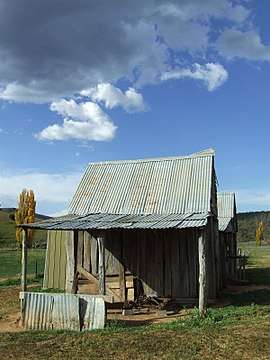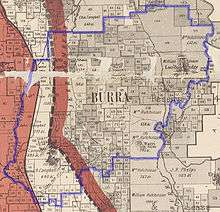Burra, New South Wales
| Burra New South Wales | |||||||||||||||
|---|---|---|---|---|---|---|---|---|---|---|---|---|---|---|---|
 London Bridge Homestead, an early Burra residence now contained within the Googong Foreshores. | |||||||||||||||
 Burra Location in New South Wales | |||||||||||||||
| Coordinates | 35°33′39″S 149°13′13″E / 35.56083°S 149.22028°ECoordinates: 35°33′39″S 149°13′13″E / 35.56083°S 149.22028°E | ||||||||||||||
| Population | 794 (2016 census)[1] | ||||||||||||||
| Postcode(s) | 2620 | ||||||||||||||
| Location |
| ||||||||||||||
| LGA(s) | Queanbeyan-Palerang Region | ||||||||||||||
| County | Murray | ||||||||||||||
| Parish | Burra | ||||||||||||||
| State electorate(s) | Monaro | ||||||||||||||
| Federal Division(s) | Eden-Monaro | ||||||||||||||
| |||||||||||||||
Burra is an Australian district and parish of rural smallholdings lying 20 kilometres to the south of Queanbeyan, New South Wales in the Queanbeyan-Palerang Region. [2]At the 2016 census, Burra had a population of 794 people.[1]
Overview
The districts bounds have been defined[3] as being the area to the south of the intersection of the Burra and Cooma Roads that contains the catchments of the Burra, Urila, Waterholes and Guises Creeks, and bounded to the East by the Queanbeyan River. The Burra Creek, whose headwaters are in the Tinderry Nature Reserve, flows through the centre of the Burra Valley to join the waters of the Queanbeyan River at the Googong Reservoir. Nearby small settlements include Royalla, Williamsdale and Michelago to the west and south. The Urila Valley is accessed from the Burra Valley and lies to the east. Burra is also a commutable distance from Australia's capital city Canberra.
It is also a parish of the County of Murray. The parish originally consisted of land between Guises Creek in the west, and Burra Creek in the east, encompassing land on both sides of Jerrabomberra Creek. A small part of this land was located to the west of the Queanbeyan-Cooma railway line and thus became part of the Australian Capital Territory in 1911.
History

The Ngarigo people originally inhabited Burra as part of their wider country lands extending south to the Australian Alps.[4] The first European camp was called 'The Creek' although it soon became known amongst the early settlers as "The Burra",[5] possibly from a local aboriginal word (for instance, the Ngarigo word "berra", meaning boomerang). The first grazing and clearing of the area began in the 1830-60s and farms in the burra valley were established at the Warm Corner, KT Park, Burra Station (the original 'creek' station), London Bridge and Lagoon. By the 1920s the local population had become large enough to support two competing cricket clubs, one at the Burra park, the other near Urila. Subdivision into smaller blocks began in the 1960s as Canberra's population expanded and has created the local regions such as those surrounding Candy Road, Badgery Road and Plumbers Road. Today the majority of the area has been subdivided in this way creating a population of 266 houses at the 2016 census.[1]
Burra lies at the northern tip of the Monaro tablelands, and shares with it some of the cooler climate of that region. Temperatures are on average two or three degrees Celsius below those in Canberra and Queanbeyan. Light falls of snow are not uncommon in the winter months.
Geology
Part of the Burra valley has always been treeless.[6] Elsewhere remnants of uncleared open woodland of Snow Gum, Candlebark, Yellow Box, Apple Box and Small Leaved Peppermint remain. Black Sally and Manna Gum are found in the cooler gullies and frost hollows. The wooded hills to the east are rocky and dry, sporting primarily Small Leafed Peppermint, Brittle Gum and Scribbly Gum. This area has never been heavily grazed and is in its original natural condition, in 2001 a part of it was protected by the creation of the Burra Creek Nature Reserve. The steeper slopes of the hills to the west of the Burra Valley, including Mount Campbell and Mount Gibraltar (and known by some Burrans as the 'Purple Veil' range due to their shaded afternoon colour) are patchily covered by a forest type similar to the wet sclerophyll that occurs further to the west on the Mount Clear Range and in Namadgi National Park.
Most of the region is underlain by the Colinton Volcanics, composed of tuff and lavas deposited in shallow water during the Silurian period. A fault runs parallel and to the east of the Burra Road, beyond which are the ancient deep sea Ordovician sediments of the Pittman formation. A few limestone lenses occur in younger rocks near to this fault, one of which forms the locally famous 'London Bridge' natural arch over the Burra Creek. In the 1920–30s there was some prospecting of iron, lead and silver along this fault but this was never commercially successful.
References
- 1 2 3 Australian Bureau of Statistics (27 June 2017). "Burra (Queanbeyan-Palerang Regional - NSW) (state suburb)". 2016 Census QuickStats. Retrieved 28 June 2017.

- ↑ "Burra". Geographical Names Board of New South Wales. New South Wales Government. Retrieved 22 July 2017.
- ↑ Moore, Bruce (1980). Burra, County of Murray. p. 2.
- ↑ "Ngarigo (NSW)". Tindale's Catalogue of Australian Aboriginal Tribes. South Australian Museum. 2000. Retrieved 2007-05-10.
- ↑ Moore, Bruce (1980). Burra, County of Murray.
- ↑ Moore, Bruce (1981). The Warm Corner, A History of the Moore Family and Their Relatives Early Pioneers of the Queanbeyan-Canberra District. p. 223. ISBN 0-9594649-1-3 (10) ISBN 978-0-9594649-1-7 (13).
External links
- The Bungendore Mirror – local press
- Regional Rainfall Measurements – inc Burra Creek
- A Google Map of Burra
- Burra Creek Nature Reserve Draft Plan of Management
- Burra Community website